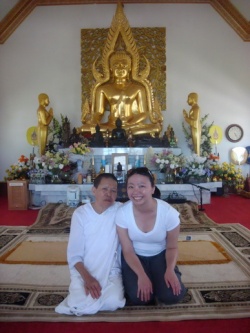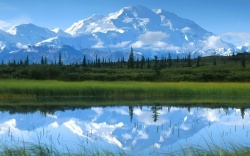Taiseki-ji
Taiseki-ji
大石寺 Taiseki-ji
The head temple of Nichiren Shoshu, located in Fujinomiya, Shizuoka Prefecture, Japan. It was founded by Nikko(1246-1333), Nichiren's designated successor. After Nichiren's death in 1282, in accord with his will, Nikko became the chief priest of Kuon-ji temple, which Nichiren had founded at Minobu. Hakiri Sanenaga, steward of the Minobu area whom Nikko had converted around 1269, had welcomed Nikko to the temple. Because Hakiri violated Nichiren's teachings, however, and refused to heed Nikko's warnings in this regard, Nikko left Minobu in 1289 with the great mandala Nichiren had inscribed (known as the Dai-Gohonzon), Nichiren's ashes, writings, and other precious items. His intention was to find a place where he could preserve Nichiren's teachings in their correct form.
Nanjo Tokimitsu, the steward of the Fuji area, invited Nikko to his estate and donated a tract of land at a place called Oishigahara (Great Stone Field). In 1290 Nikko, with other believers, built a temple called Dai-bo(Grand Lodging), and this is considered the origin of Taiseki-ji (taiseki is another reading of the characters oishi, meaning great stone). Thereafter Nikko's disciples began to establish lodging temples surrounding Dai-bo. Nikko founded this new temple in accordance with Nichiren's instruction that the sanctuary of Hommon-ji (Temple of Essential Teaching) be built at the foot of Mount Fuji.
The Dai-bo had a main hall, a place for the training and education of priests, and priests' living quarters. In 1298, when Nikko moved to the nearby Omosu Seminary he had established, Nikko's six elder disciples, including Nichimoku, managed Taiseki-ji. Nichimoku, who privately received the transfer of Nichiren's teachings from Nikko, stayed at Taiseki-ji. In 1332 Nikko officially appointed Nichimoku chief priest of Taiseki-ji. In 1333 Nichimoku, having transferred the office of chief priest to Nichido, set out for Kyoto with the priests Nichigo and Nichizon to remonstrate with the imperial court. Nichimoku died en route, however, at Tarui in Mino Province. The two priests who had accompanied him went on to Kyoto to fulfill the purpose of their journey; Nichizon remained there and Nichigo returned to Taiseki-ji. Nichigo then claimed ownership of the Renzo-bo, previously Nichimoku's lodging temple, and its environs, stating that Nichimoku had willed it to him. This sparked a dispute that lasted for some seventy years, during which time Taiseki-ji declined. Nichiu (1402-1482), the ninth chief priest, restored stability to Taiseki-ji for a time, but in the ensuing centuries it saw further periods of decline and recovery. From the mid-fifteenth through the early sixteenth century, a number of structures were added, including a reception hall, a temple to house an image of Nichiren, and a five-storied pagoda.
In the latter half of the twentieth century, Taiseki-ji was completely remodeled, and modern buildings erected in architectural harmony with the older structures. The Hoan-den, enshrining the Dai-Gohonzon, was built in 1955; the Grand Lecture Hall in 1958; the Grand Transient Castle, a rest house for visitors, in 1960; the Grand Reception Hall in 1964; and in 1972 the Grand Main Temple, or Sho-Hondo, which was intended to serve as the "sanctuary of Hommon-ji temple" mentioned by Nichiren. These buildings were all constructed through the financial contributions of Soka Gakkai members.
During the tenure of Nikken, the sixty-seventh chief priest, however, most of these structures—those completed during the tenure of his predecessor, Nittatsu—were demolished: the Grand Transient Castle in 1989, the Grand Reception Hall in 1995, and the Grand Main Temple in 1998. Moreover, in 1991 Nikken excommunicated the Soka Gakkai, which, in the latter half of the twentieth century, had revived the practice of and had been widely propagating Nichiren's teachings, thereby bringing about the prosperity of Taiseki-ji and Nichiren Shoshu.
Contrary to Nikken's plans, which were intended to disband the Soka Gakkai and bring many of its members directly under Nichiren Shoshu, the Soka Gakkai continued to grow and flourish after the excommunication. See also Nichiren Shoshu; Soka Gakkai.

